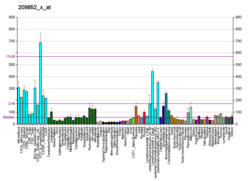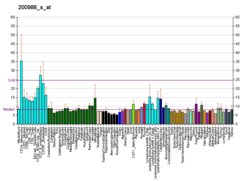PSME3
Proteasome activator complex subunit 3 is a protein that in humans is encoded by the PSME3 gene.[5][6]
Function
The 26S proteasome is a multicatalytic proteinase complex with a highly ordered structure composed of 2 complexes, a 20S core and a 19S regulator. The 20S core is composed of 4 rings of 28 non-identical subunits; 2 rings are composed of 7 alpha subunits and 2 rings are composed of 7 beta subunits. The 19S regulator is composed of a base, which contains 6 ATPase subunits and 2 non-ATPase subunits, and a lid, which contains up to 10 non-ATPase subunits. Proteasomes are distributed throughout eukaryotic cells at a high concentration and cleave peptides in an ATP/ubiquitin-dependent process in a non-lysosomal pathway. An essential function of a modified proteasome, the immunoproteasome, is the processing of class I MHC peptides. The immunoproteasome contains an alternate regulator, referred to as the 11S regulator or PA28, that replaces the 19S regulator. Three subunits (alpha, beta and gamma) of the 11S regulator have been identified. This gene encodes the gamma subunit of the 11S regulator. Six gamma subunits combine to form a homohexameric ring. Two transcript variants encoding different isoforms have been identified.[6]
Interactions
References
- 1 2 3 GRCh38: Ensembl release 89: ENSG00000131467 - Ensembl, May 2017
- 1 2 3 GRCm38: Ensembl release 89: ENSMUSG00000078652 - Ensembl, May 2017
- ↑ "Human PubMed Reference:".
- ↑ "Mouse PubMed Reference:".
- ↑ Albertsen HM, Smith SA, Mazoyer S, Fujimoto E, Stevens J, Williams B, Rodriguez P, Cropp CS, Slijepcevic P, Carlson M (Dec 1994). "A physical map and candidate genes in the BRCA1 region on chromosome 17q12-21". Nat Genet. 7 (4): 472–9. doi:10.1038/ng0894-472. PMID 7951316.
- 1 2 "Entrez Gene: PSME3 proteasome (prosome, macropain) activator subunit 3 (PA28 gamma; Ki)".
- 1 2 Zhang Z, Zhang R (Mar 2008). "Proteasome activator PA28 gamma regulates p53 by enhancing its MDM2-mediated degradation". EMBO J. 27 (6): 852–64. doi:10.1038/emboj.2008.25. PMC 2265109. PMID 18309296.
Further reading
- Coux O, Tanaka K, Goldberg AL (1996). "Structure and functions of the 20S and 26S proteasomes". Annu. Rev. Biochem. 65: 801–47. doi:10.1146/annurev.bi.65.070196.004101. PMID 8811196.
- Goff SP (2003). "Death by deamination: a novel host restriction system for HIV-1". Cell. 114 (3): 281–3. doi:10.1016/S0092-8674(03)00602-0. PMID 12914693.
- Nikaido T, Shimada K, Shibata M, Hata M, Sakamoto M, Takasaki Y, Sato C, Takahashi T, Nishida Y (1990). "Cloning and nucleotide sequence of cDNA for Ki antigen, a highly conserved nuclear protein detected with sera from patients with systemic lupus erythematosus". Clin. Exp. Immunol. 79 (2): 209–14. doi:10.1111/j.1365-2249.1990.tb05180.x. PMC 1534747. PMID 1968796.
- Miki Y, Swensen J, Shattuck-Eidens D, Futreal PA, Harshman K, Tavtigian S, Liu Q, Cochran C, Bennett LM, Ding W (1994). "A strong candidate for the breast and ovarian cancer susceptibility gene BRCA1". Science. 266 (5182): 66–71. Bibcode:1994Sci...266...66M. doi:10.1126/science.7545954. PMID 7545954.
- Harshman K, Bell R, Rosenthal J, Katcher H, Miki Y, Swenson J, Gholami Z, Frye C, Ding W, Dayananth P (1995). "Comparison of the positional cloning methods used to isolate the BRCA1 gene". Hum. Mol. Genet. 4 (8): 1259–66. doi:10.1093/hmg/4.8.1259. PMID 7581362.
- Jacob A, Kandpal G, Patanjali SR, Kandpal RP (1995). "Molecular cloning and expression pattern of genes from a 470 Kb region near BRCA1 locus on chromosome 17q21". Oncogene. 11 (5): 981–6. PMID 7675458.
- Seeger M, Ferrell K, Frank R, Dubiel W (1997). "HIV-1 tat inhibits the 20 S proteasome and its 11 S regulator-mediated activation". J. Biol. Chem. 272 (13): 8145–8. doi:10.1074/jbc.272.13.8145. PMID 9079628.
- Kandil E, Kohda K, Ishibashi T, Tanaka K, Kasahara M (1997). "PA28 subunits of the mouse proteasome: primary structures and chromosomal localization of the genes". Immunogenetics. 46 (4): 337–44. doi:10.1007/s002510050281. PMID 9218537.
- McCusker D, Jones T, Sheer D, Trowsdale J (1998). "Genetic relationships of the genes encoding the human proteasome beta subunits and the proteasome PA28 complex". Genomics. 45 (2): 362–7. doi:10.1006/geno.1997.4948. PMID 9344661.
- Knowlton JR, Johnston SC, Whitby FG, Realini C, Zhang Z, Rechsteiner M, Hill CP (1998). "Structure of the proteasome activator REGalpha (PA28alpha)". Nature. 390 (6660): 639–43. Bibcode:1997Natur.390..639K. doi:10.1038/37670. PMID 9403698.
- Kohda K, Ishibashi T, Shimbara N, Tanaka K, Matsuda Y, Kasahara M (1998). "Characterization of the mouse PA28 activator complex gene family: complete organizations of the three member genes and a physical map of the approximately 150-kb region containing the alpha- and beta-subunit genes". J. Immunol. 160 (10): 4923–35. PMID 9590240.
- Madani N, Kabat D (1998). "An endogenous inhibitor of human immunodeficiency virus in human lymphocytes is overcome by the viral Vif protein". J. Virol. 72 (12): 10251–5. PMC 110608. PMID 9811770.
- Wójcik C, Tanaka K, Paweletz N, Naab U, Wilk S (1999). "Proteasome activator (PA28) subunits, alpha, beta and gamma (Ki antigen) in NT2 neuronal precursor cells and HeLa S3 cells". Eur. J. Cell Biol. 77 (2): 151–60. doi:10.1016/s0171-9335(98)80083-6. PMID 9840465.
- Simon JH, Gaddis NC, Fouchier RA, Malim MH (1998). "Evidence for a newly discovered cellular anti-HIV-1 phenotype". Nat. Med. 4 (12): 1397–400. doi:10.1038/3987. PMID 9846577.
- Mulder LC, Muesing MA (2000). "Degradation of HIV-1 integrase by the N-end rule pathway". J. Biol. Chem. 275 (38): 29749–53. doi:10.1074/jbc.M004670200. PMID 10893419.
- Araya R, Takahashi R, Nomura Y (2002). "Yeast two-hybrid screening using constitutive-active caspase-7 as bait in the identification of PA28gamma as an effector caspase substrate". Cell Death Differ. 9 (3): 322–8. doi:10.1038/SJ.CDD.4400949. PMID 11859414.
- Sheehy AM, Gaddis NC, Choi JD, Malim MH (2002). "Isolation of a human gene that inhibits HIV-1 infection and is suppressed by the viral Vif protein". Nature. 418 (6898): 646–50. Bibcode:2002Natur.418..646S. doi:10.1038/nature00939. PMID 12167863.
- Huang X, Seifert U, Salzmann U, Henklein P, Preissner R, Henke W, Sijts AJ, Kloetzel PM, Dubiel W (2002). "The RTP site shared by the HIV-1 Tat protein and the 11S regulator subunit alpha is crucial for their effects on proteasome function including antigen processing". J. Mol. Biol. 323 (4): 771–82. doi:10.1016/S0022-2836(02)00998-1. PMID 12419264.
External links
- PSME3 human gene location in the UCSC Genome Browser.
- PSME3 human gene details in the UCSC Genome Browser.






